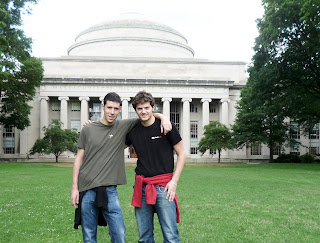Who we are
We are the developers of Plastic SCM, a full version control stack (not a Git variant). We work on the strongest branching and merging you can find, and a core that doesn't cringe with huge binaries and repos. We also develop the GUIs, mergetools and everything needed to give you the full version control stack.
If you want to give it a try, download it from here.
We also code SemanticMerge, and the gmaster Git client.
Who we are
We are the developers of Plastic SCM, a full version control stack (not a Git variant). We work on the strongest branching and merging you can find, and a core that doesn't cringe with huge binaries and repos. We also develop the GUIs, mergetools and everything needed to give you the full version control stack.
If you want to give it a try, download it from here.
We also code SemanticMerge, and the gmaster Git client.
Our first day at the GNOME & Mono Festival of Love 2012
 |
| Ruben & Jesus at MIT |
Who we are
We are the developers of Plastic SCM, a full version control stack (not a Git variant). We work on the strongest branching and merging you can find, and a core that doesn't cringe with huge binaries and repos. We also develop the GUIs, mergetools and everything needed to give you the full version control stack.
If you want to give it a try, download it from here.
We also code SemanticMerge, and the gmaster Git client.
Simulating dynamic inheritance in Plastic SCM 4 (or almost so)
Tuesday, June 26, 2012
Ma Nu
branching
1
Comments
As you know, the old dynamic inheritance is not available in Plastic SCM 4. It was a Plastic SCM 3 feature that was cool, but hard to understand, so it was overlooked by a large number of development teams.Tuesday, June 26, 2012 Ma Nu branching 1 Comments
How it worked
The child branches created with dynamic inheritance didn't have a static branch base; the base was always changing as soon as its parent branch was.
 |
| Plastic SCM 3 dynamic inheritance |
Inside Plastic SCM 4, the same behavior can be easily achieved by merging the last main changeset into the task branches, but we have to admit that this is a manual operation and in a huge environment with a lot of developers the periodical merge operation can be easily forgotten.
That being said, it seems that the dynamic inheritance was a really powerful feature. Indeed it was, but let's see the not-so-pretty side too.
Dynamic inheritance weak points
It was slow. The workspace resolution was an expensive operation.
Very complicated to use and understand for a regular user.
It was really easy to end up with completely wrong or broken code.
You were never able to be 100% sure of a changeset configuration. It was "selector-depending".
The distributed scenarios were complete madness.
Simulating the strongest part
Having the "core" code changes automatically applied in the working branch was great, now using the new "merge-to" feature we can get it back.
The "merge-to" feature is able to perform merge operation on the fly, without having to change the current working branch and merge it manually. We are able to use the Branch Explorer and say, "Merge this branch with this other branch," and the merge is done in the server. Obviously the merge operation must be automatic, both contributors merges are not allowed. This restriction was also present in the Plastic SCM 3 dynamic inheritance system.
After check-in trigger
I'm going to simulate the dynamic inheritance system using a c# trigger. This trigger will be monitoring the check-in operations affecting our desired branch -- in this case the /main branch. Every time we have a new changeset in the /main branch the changes will be merged-to the target child branches. We will use an after-check-in trigger.
Trigger workflow
This is how the main method of the trigger code looks:
static int Main(string[] args)
{
try
{
TriggerParams parameters = GetExecParams(args);
ArrayList childBranches = GetChildBranches(parameters);
MergeToBranches(childBranches, parameters);
}
catch (Exception e)
{
Console.WriteLine("Error executing trigger : " + e.Message);
}
return 0;
}
These are the parameters we need to run the trigger:
- The branch name we want to track for new changes.
- A workspace path to issue the Plastic SCM operations.
- A file where the trigger output is going to be written.
- A mapping file for email notifications (optional).
... /main/scm003#iamamaddeveloper@gmail.com /main/scm004#mlucio@codicesoftware.com /main/scm005 /main/scm006#theCrazyDev@codicesoftware.com ...
If the merge-to can't be accomplished, an email will be sent if there's any specified for the branch. If no custom branches file is provided, the merge to operation will be applied for all the child branches of the tracked branch.
Results
Here you can see how the automatic merges are done by the trigger:
 |
| Branches auto-updated with /main branch changes |
And if something can't be merged in an automatic way the developer will receive an email warning about the situation:
 |
| E-mail sent by the trigger warning the develop to merge manually the main branch changes |
Download
HERE you can download the code. Enjoy it!

Manuel Lucio
I'm in charge of the Customer Support area.I deal with complex setups, policies and working methodologies on a daily basis.
Prior to taking full responsibility of support, I worked as software engineer. I have been in charge of load testing for quite some time, so if you want to know how well Plastic compares to SVN or P4 under a really heavy load, I'm your guy.
I like to play with Arduino GPS devices, mountain biking and playing tennis.
You can find me hooked to my iPhone, skate-boarding or learning Korean... and also here @mrcatacroquer.
Who we are
We are the developers of Plastic SCM, a full version control stack (not a Git variant). We work on the strongest branching and merging you can find, and a core that doesn't cringe with huge binaries and repos. We also develop the GUIs, mergetools and everything needed to give you the full version control stack.
If you want to give it a try, download it from here.
We also code SemanticMerge, and the gmaster Git client.
Xlinks and branch per task in a DVCS environment.
Wednesday, June 20, 2012
Pablo Santos
distributed
0
Comments
I’m going to tell how we use the Xlinks down here at the Plastic SCM dev team combined with replication.
Wednesday, June 20, 2012 Pablo Santos distributed 0 Comments
No surprises if I tell you we use Plastic SCM to handle the plastic development :)
Yes, you know, eating our own’s dog food and all that.
Well, if you take a look at our items view you’ll see something like the following:

This screenshot is coming from my laptop, and I have a server (using SQLite backend) installed on it, and then I push/pull changes from the central.
We’ve 5 main directories and each of them is pointing to a different repository.
Pulling branches
Ok, now, as I said I work replicated without direct conn to the central server. So, considering a single task I need to pull can have like 3 associated branches on 3 different repositories… how do I manage to make the replication process simple?Look, I have a sync view defined with all the sources (on localhost) and destinations (on Diana). So I update everything, then filter by the branch I want to pull (or push), multiselect on the different repos, and click on “pull branch”.
And hence I can get all the branches I’m interested on with a single click (or push them!).

Was it helpful?

Pablo Santos
I'm the CTO and Founder at Códice.I've been leading Plastic SCM since 2005. My passion is helping teams work better through version control.
I had the opportunity to see teams from many different industries at work while I helped them improving their version control practices.
I really enjoy teaching (I've been a University professor for 6+ years) and sharing my experience in talks and articles.
And I love simple code. You can reach me at @psluaces.
Who we are
We are the developers of Plastic SCM, a full version control stack (not a Git variant). We work on the strongest branching and merging you can find, and a core that doesn't cringe with huge binaries and repos. We also develop the GUIs, mergetools and everything needed to give you the full version control stack.
If you want to give it a try, download it from here.
We also code SemanticMerge, and the gmaster Git client.
Browsing remote branches, so great it hurts!
Thursday, June 07, 2012
Pablo Santos
differences
0
Comments
I'm going to show you a simple feature that has been there for years but I'm not sure you're all aware of it.
Thursday, June 07, 2012 Pablo Santos differences 0 Comments
The scenario
I'm working on my laptop, and I have a local Plastic SCM server installed on it because I work in a distributed way. I checkin locally and push/pull changes from the company's central.Ok, now I need to take a look at an old change that was initially modified on branch SCM9162.
The problem
I go to my branch view and try to find the branch filtering the list.
No luck, the branch is not there.
Plastic SCM replicas are not full replicas, we do support partial replication, which allows you to create light replicas, extremely convenient.
But today I'm looking for an old branch that I never replicated to my local repo...
The solution
I click on the "advanced" button on the branch view and see the following:My current query is looking for the branches with changes in the last 10 days... in my current repo.
But I can customize the query and search for branches on another repo on a different server!
Now I get the full list of branches on the central repo on the central server and filter to find the branch I'm looking for.
The great part is that you can diff the remote branch, which is sorta normal for old centralized SCMs but out of the scope of the modern DVCS... except Plastic! So I go, right click on it, and browse the diff... without having to pull the remote branch to my very clean and small local repo! :)

Pablo Santos
I'm the CTO and Founder at Códice.I've been leading Plastic SCM since 2005. My passion is helping teams work better through version control.
I had the opportunity to see teams from many different industries at work while I helped them improving their version control practices.
I really enjoy teaching (I've been a University professor for 6+ years) and sharing my experience in talks and articles.
And I love simple code. You can reach me at @psluaces.
Popular Posts
- The version control timeline
- Towards Semantic Version Control
- Merge recursive strategy
- Configuring ignored items in your workspace
- Designing a better user experience
- Linus on branching...
- The fastest way to insert 100K records
- Put your hands on a programming-language-aware, refactor ready, merge tool
- The state of the art in merge technology
- How to link repositories using Xlinks
Labels
- Agile
- backend
- Bamboo
- best practices
- branch explorer
- branching
- cloud
- code review
- configuration
- continuous integration
- delphi
- DevOps
- differences
- distributed
- docker
- dotnet
- eclipse
- fun
- git
- integrations
- mergebot
- merging
- migration
- mono
- news
- performance
- plastic
- plasticfs
- scm
- Scrum
- semantic
- semanticmerge
- solaris
- testing
- triggers
- tube
- unity
- visual studio
- WebAdmin
- WebUI








0 comentarios: